Whey protein is one of the staple and most essential items in the supplement arsenal of many athletic persons. But it’s not just for athletes and bodybuilders, anyone who wants to increase their daily intake of protein can benefit from this convenient and quick source of complete protein that provides the body with a good dose of all the essential amino acids it needs.
There are thousands of whey protein brands on the market, most of which come loaded with different additives, including artificial flavors, sweeteners, thickeners, preservatives, etc. But consuming isolated protein with a bunch of nutritionally-empty ingredients isn’t the healthiest way to boost your intake of this key macronutrient.
The human body is designed to work with whole foods. It digests, absorbs and utilizes protein and other nutrients more efficiently when they are consumed as whole foods. So it can be argued that the best and most effective way to consume whey protein is by incorporating it into a whole food meal, such as a smoothie.
And if that’s what you’re going to do, you may as well skip all the junk-filled products and opt for a natural, pure whey protein powder, which is the main focus of this post.
The following are five of the best and cleanest whey protein powders that you can use to make a healthy smoothie.
1. Promix Nutrition
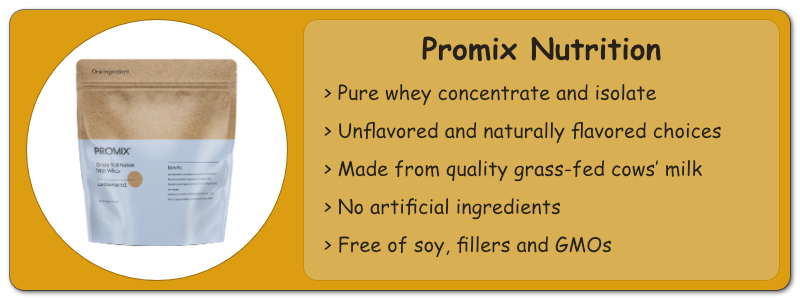
Promix Nutrition whey protein
Promix Nutrition makes some of the cleanest sports nutritional supplements on the market. Their products are free from artificial ingredients, GMOs, hormones, antibiotics, and any unnecessary fillers or additives. They sell soy-free whey protein in concentrate and isolate forms.
This brand uses quality whey made from grass-fed cows’ milk, and they test their products for purity in a third-party lab (you can look up the lab report for any specific batch on their website). They used to source the whey from Irish farms but they’ve recently switched to North American farms.
The unflavored powder only contains one additional ingredient: Sunflower lecithin (improves mixability). You can also choose from a few different flavored versions that use mild, natural flavors and natural sweeteners. The unflavored powder is quite bland, but it’s more versatile and can be added to different cold/hot drinks, baked goods, etc.
Key Benefits
- Free of artificial ingredients, hormones and antibiotics.
- Free of GMOs, soy, gluten and fillers.
- Made from quality grass-fed cows’ milk.
- Unflavored powder contains no additives (with or without lecithin).
- Flavored powders only contain natural ingredients.
- 25 grams of protein per serving in the concentrate.
- 30 grams of protein per serving in the isolate.
- Third-party lab testing for heavy metals.
Drawbacks
- It’s a little pricey.
- Only ships to the United States.
Click here to learn more and order Promix Nutrition’s protein!
2. Naked Nutrition
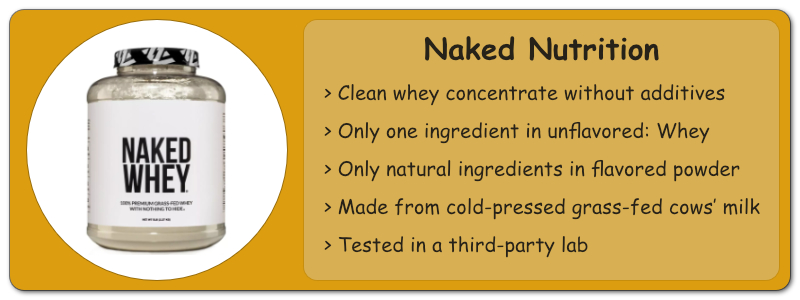
Naked Nutrition whey protein
It’s called Naked Nutrition because this company’s products are pretty “naked” in terms of ingredients. They are not dressed with any artificial flavors or sweeteners or any junk additives you often see in lots of other products. This is one of the best brands of pure whey protein on the market for those who prefer to add their own flavors in their smoothie or shake.
Naked Nutrition’s whey is sourced from grass-fed cows’ milk from farms in California. It is free of GMOs and growth hormones and it’s tested for heavy metals in a third-party lab. In addition to the unflavored powder, they offer a few naturally flavored and sweetened options (chocolate, vanilla and strawberry).
This product doesn’t contain any emulsifiers (e.g. lecithin) so mixing it by hand can be a challenge. It’s better mixed in a blender with almond milk (or any other milk) and some sweet fruits for flavor.
Key Benefits
- Plain whey protein with no fillers.
- Made from grass-fed cows’ milk from U.S. farms.
- Processed in an FDA-approved facility.
- Cold pressing preserves natural nutrients in whey.
- No artificial flavors or sweeteners.
- 25 grams protein per serving.
- Third-party lab testing.
Drawbacks
- Premium brand — not the cheapest you can find.
- Only sold in 5-pound tubs.
- Does not ship outside the U.S. at the moment.
Click here to learn more and order Naked Nutrition’s protein!
3. Biochem
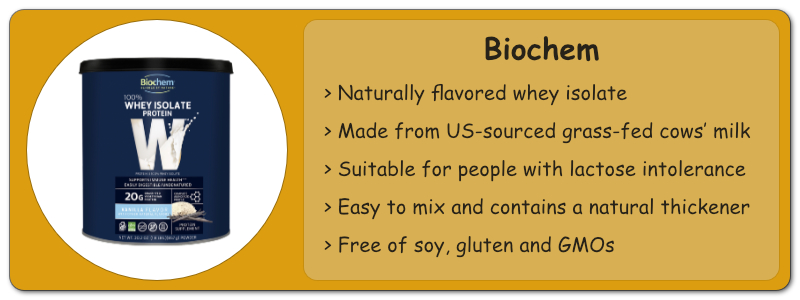
Biochem whey protein
Biochem is another decent brand of grass-fed whey protein that is sourced and made in the USA. They use minimal ingredients without artificial flavors or sweeteners. Their protein is soy-free and they use lecithin that is sourced from sunflower.
Biochem’s whey isolate comes in a few natural flavors that include vanilla, chocolate and coconut. The natural sweeteners they use vary from one flavor to another, but they mainly use either organic cane sugar or rebaudioside A (stevia leaf extract). The “Natural Flavor” option contains natural vanilla without any sweeteners, which gives you total control of how sweet you want your drink to be.
Key Benefits
- Made from grass-fed, USA-sourced cows’ milk.
- No artificial flavors or sweeteners.
- Natural vanilla and chocolate flavors.
- Low-lactose whey protein isolate.
- Mixes very easily with milk or water.
- 20 grams of protein per serving.
Drawbacks
- The vanilla flavor is mild (good with smoothies but not with plain water).
- Some flavors contain stevia (not everyone likes this).
- Xanthan gum (thickener) may cause bloating for some people.
Click here to learn more and order Biochem’s protein!
4. NOW Foods
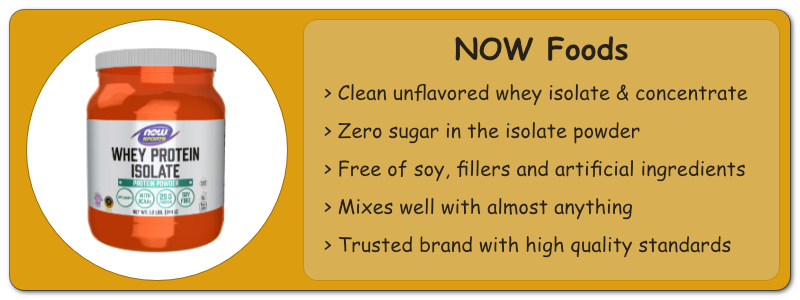
NOW Foods whey protein
This brand doesn’t really need much introduction since it is one of the most trustworthy brands of dietary supplements in the world. They use high-quality ingredients, they test everything for purity and safety, and their pricing is reasonable.
NOW’s whey protein isolate comes in unflavored and flavored versions with natural ingredients and without soy. The unflavored powder is very clean with just one additional ingredient: Sunflower lecithin. It is unsweetened so you get to control the sweetness to your taste. The flavored ones contain two natural sweeteners: Xylitol and stevia.
Key Benefits
- Unflavored whey isolate with low fat and zero sugar.
- Contains no soy or additives.
- Produced in a GMP-compliant facility.
- High-quality and lab-tested ingredients.
- Easy to mix into shakes and smoothies.
- 25 grams protein per serving (isolate).
Drawbacks
- Flavored formulas contain stevia (choose unflavored to avoid).
Click here to learn more and order NOW Foods’ protein!
5. MyProtein Impact
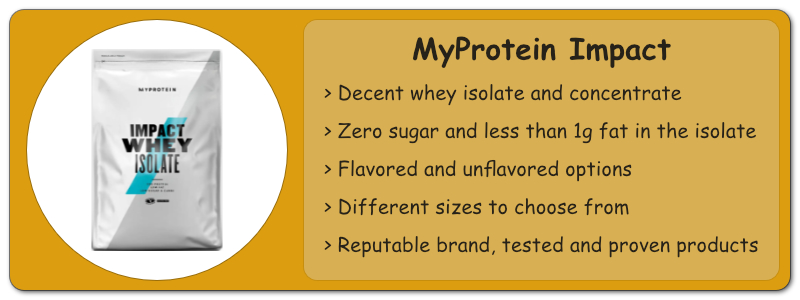
MyProtein Impact whey protein
MyProtein is a very popular nutrition brand among athletic people around the world. The company is headquartered in the UK but they also operate in the USA and have partnerships with many distributors and retailers in different countries. They are reputable for having high quality standards and proven products.
The Impact whey protein is their flagship product that comes in both concentrate and isolate forms with several different flavors. This company does use artificial flavors and artificial sweeteners in the flavored powders, but if you want to avoid those, you can choose the cleaner unflavored powder, which only contains lecithin as an additional ingredient.
Key Benefits
- Pure unflavored whey isolate and concentrate.
- Plenty of flavors to pick from if you prefer flavored.
- An established brand that sells quality products.
- In-house testing and third-party validation.
- 22 grams protein per serving in the isolate formula.
- 19 grams protein per serving in the concentrate.
Drawbacks
- The price is on the higher end.
- Flavored blends contain artificial flavors and sweeteners.
- Contains soy (lecithin).
Click here to learn more and order MyProtein Impact!
Frequently Asked Questions
The following are some of the most common questions about whey protein with brief answers that you might find helpful when shopping for and using a protein supplement.
How to Reduce Foam in a Protein Shake or Smoothie?
Excessive foaming is one of the common issues consumers complain about when making a whey protein shake or smoothie. In general, all whey powders produce foam when shaken or blended, and the fewer additives it contains, the more foam it produces.
That’s sadly true, you can expect more frothiness when you work with pure whey protein that doesn’t contain thickeners and other fillers. There are, however, a few tricks that can help you avoid or at least reduce the formation of foam. Try the following:
- If you are making a smoothie, blend all of the other ingredients first and then add the protein powder and blend at a lower speed. Adding the protein gradually may also help.
- A tablespoon or two of coconut oil added to the mix can also inhibit foaming, in addition to the added health benefits. You can use any other type of oil you prefer.
- Let it settle for 10 to 20 minutes before drinking.
Is Whey Isolate Better Than Concentrate?
Whey protein concentrate is more common and used by the majority of manufacturers. It is easier to produce and requires less processing, so it comes at a lower price. The amount of protein in a concentrate powder can significantly vary from one producer to another and can range from 25% to 80% by weight.
On the other hand, whey isolate is produced by further processing and filtration of the concentrate in order to remove most of the sugar, fat and other milk components. The isolate powder typically has a protein content of 90% or more by weight.
So, the isolate delivers more protein in each serving, but this comes at a higher price. One major advantage of the isolate is that since it usually only contains negligible trace amounts of milk sugar (lactose), it can be more suitable for people who suffer from lactose intolerance.
But again, the composition and purity of whey powder can greatly vary from one brand to another. Some concentrates have a very high percentage of protein and a very low percentage of sugar and fat, making them almost as good as an isolate.
Not all whey concentrates are created equal, and the same goes for isolates. So, take a close look at the label and compare the nutritional profiles of the specific products you’re considering in order to get a better idea of what you’re buying before you buy it.
What to Look For in a Whey Protein Powder?
If this is your first time buying whey protein you may be overwhelmed by the endless choices out there. Trying to look for advice and recommendations in other users’ reviews may only make you more confused, especially since most reviews are very subjective and relative. It’s not uncommon to see a number of users praising a certain product as the best they’ve ever tasted while others swear it’s the worst!
Apart from personal opinions and reviews, there are a few important factors that you should keep in mind as you search for the best whey protein powder for you. The following are some of the most notable points to look into.
- Milk source: Whey comes from cows’ milk and one of the key questions to ask any manufacturer is where they source their milk from. Many premium brands use grass-fed cows’ milk that is free from hormones and antibiotics, which is arguable a nutritionally superior and healthier option.
- Heavy metal testing: Whey and various other ingredients may be susceptible to heavy metal contamination, which is why testing for common heavy metals is a crucial safety measure in this industry. Some of the larger manufacturers have their own in-house lab where they test ingredients and finished products for heavy metal content, while others send samples to be tested in a third-party lab.
- Flavor: Plain whey protein is chalky and unpalatable, and the purer and cleaner it is, the more bland and less “natural” it tastes. Choosing an unflavored powder and adding your own flavorful healthy ingredients to make a smoothie is the safest option. But if you must choose a flavored powder, go with common natural flavors like vanilla and chocolate.
- Mixability: Whey powder on its own doesn’t normally mix easily with water or other liquids. That’s why most products contain an emulsifier to improve mixability. The most commonly used emulsifier is lecithin, which is usually sourced from either soy or sunflower. Powders that don’t contain lecithin or any other emulsifier are fine for mixing in a blender, otherwise, you probably want to avoid those.
- Sweeteners: There are different types of sweeteners used in protein powders. These included natural sugars, such as cane sugar and coconut sugar; natural sugar alternatives, such as stevia and xylitol; and artificial sweeteners, such as sucralose and acesulfame potassium. Added sugar of course comes with extra calories while substitutes come with their own disadvantages, the most annoying of which is a nasty taste and aftertaste in case of stevia and artificial sweeteners.
- Thickeners: Xanthan gum is often used as a thickening agent. It makes the drink thicker and more filling, which is something that some people enjoy. On the other hand, the presence of thickeners can make a smoothie too thick and it can potentially cause a feeling of being bloated, which may be troublesome for some people.
Why Does The Taste and Color Vary From Batch to Batch?
The color and taste of any whey protein brand can indeed vary from time to time. That is mostly a result of variances in the milk used to make the whey. Some companies source their milk from different farms and some may change farms from time to time.
But even when the milk comes from the same farm, the color and taste can still vary depending on what the cows are fed. This can be particularly noticed with grass-fed cows that feed on fresh green grass during some seasons while feeding on hay during other seasons (winter).
Why do some protein containers come partially filled?
You can find plenty of complaints on Amazon and other websites from customers thinking they’ve been duped because the container they received was half empty or only partially filled. Those complaints aren’t necessarily factual because what many customers don’t realize is that protein powders are sold by weight, not volume. So, if you receive a big container that is only half full, weigh its contents and compare it to the weight listed on the label before you rush to ask for a refund.
Does Whey Protein Cause Bloating and Gas?
Bloating and gas are two widely experienced side effects of consuming whey protein. The most common cause of such problems is sensitivity to dairy, or more specifically lactose intolerance. If you are lactose intolerant, using whey isolate with low/zero sugar content can help reduce or eliminate these side effects.
It is also likely that other ingredients may be causing bloating and gas for you, such as thickeners (xanthan gum) or sugar substitutes (stevia).
Some people may just not tolerate whey protein altogether. If you have tried different lactose-free and additive-free products and still experienced uncomfortable side effects, then it’s probably better to consider switching to other types of protein, such as egg protein or vegan pea protein.
*Disclosure: This post contains affiliate links that may result in a small commission paid to the author for referred sales at no additional cost to the buyer. These commissions help compensate us for the time and effort we put into researching, creating and publishing content. Your support is greatly appreciated and will help us continue sharing impartial articles and reviews.







Recent Comments